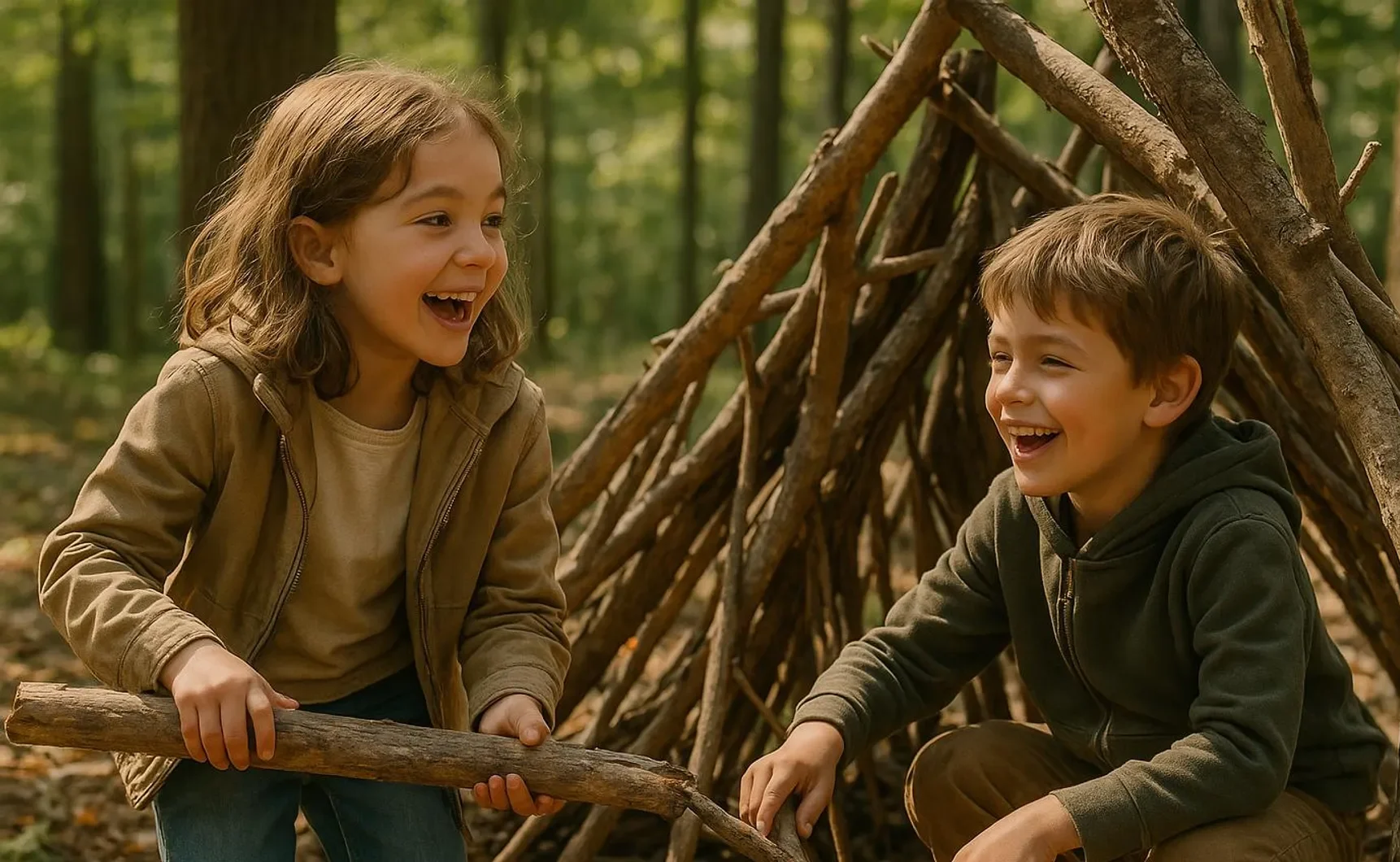In today’s hyper-connected world, the battle over screen time is a familiar struggle for parents everywhere. But for those of us raising our families in the breathtaking High Country, the allure of glowing screens can feel particularly at odds with the natural wonderland just outside our doors. A recent Pew Research Center study found that while most parents prioritize managing screen time, nearly half feel they could be doing a better job. If you’re nodding along, you’re not alone.
The good news? Our unique mountain environment offers the perfect antidote to screen addiction. This comprehensive guide will help you create a healthy digital balance for your family — not by imposing rigid restrictions, but by embracing the lifestyle our beautiful surroundings afford. It’s about trading screen time for summit views and fostering a love for the outdoors that will last a lifetime.
Understanding the Screen Time Challenge
Before we dive into solutions, it’s important to understand the scope of the challenge we’re facing. According to the American Academy of Pediatrics, the average child in the United States spends more than five hours on screens every day. That’s a significant portion of their waking hours spent in front of a device rather than engaging with the physical world around them.
The World Health Organization recommends that children under age five spend no more than one hour per day on screens, and children under age one should have no screen time at all (except for video chatting). For older children, the focus shifts from strict time limits to ensuring that screen use doesn’t interfere with sleep, physical activity, and face-to-face social interaction.
But here’s the reality: implementing these guidelines can feel overwhelming, especially when screens have become so deeply embedded in our daily lives. That’s where intentional parenting and our High Country lifestyle can make all the difference.
The High Country Advantage: Nature as Your Co-Parent
Living in the High Country gives us a powerful tool in the fight against screen addiction: nature itself. The mountains, forests, and rivers surrounding us are not just a backdrop — they are a playground, a classroom, and a sanctuary. When we encourage our children to unplug and explore, we’re not just reducing their screen time; we’re enriching their lives in countless ways.
Physical Health Benefits
Swapping video games for a hike on a local trail is one of the simplest ways to get your kids moving and build healthy habits. The physical benefits of outdoor activity are well-documented: improved cardiovascular health, stronger muscles and bones, better coordination, and a reduced risk of childhood obesity. For ideas on where to start with your family, check out our comprehensive guide to the Best Family Hikes in the High Country (By Age Group).
Mental Well-being and Emotional Resilience
The pressures of social media and online life can take a significant toll on young minds. Time spent in nature has been scientifically proven to reduce stress hormones, improve focus and attention span, and boost overall mental health. This is especially crucial in rural areas where access to mental health resources may be limited. We explored this topic in depth in our post on Mental Health Awareness for Kids & Teens in Rural Communities.
Creativity and Imagination
Unstructured outdoor play is a powerful catalyst for creativity and problem-solving skills. Away from the prescriptive world of apps and games, children are free to invent their own adventures, build forts from fallen branches, create imaginary worlds, and let their imaginations run wild. This type of open-ended play is essential for cognitive development and cannot be replicated on a screen.
Practical Strategies for a Screen-Smart Household
Creating a healthy digital ecosystem at home doesn’t have to be a constant battle. The key is to establish clear expectations, create supportive structures, and model the behavior you want to see. Here are practical strategies that work with, not against, your family’s lifestyle:
The “Device Parking Lot” Strategy
Designate a central location in your home where all devices are “parked” during specific times, such as meals and bedtime. This could be a decorative basket in the kitchen, a charging station in the entryway, or a drawer in the living room. The crucial element is that this rule applies to everyone — including parents. When adults model healthy screen habits, children are far more likely to follow suit.
Make this a positive ritual rather than a punishment. You might say, “It’s time for our devices to rest so we can enjoy dinner together,” rather than framing it as taking something away. This subtle shift in language can make a significant difference in how children perceive and accept the boundary.
Establish Tech-Free Zones
Create certain areas of your home that are permanently screen-free zones. Bedrooms and the dinner table are excellent places to start. Research from Mayo Clinic shows that screens in bedrooms are associated with reduced sleep quality and quantity in children. By keeping devices out of sleeping areas, you create sanctuaries for rest and quiet activities like reading.
The “First-Hour, Last-Hour” Rule
For older children and teens, consider implementing a rule where the first hour after waking up and the last hour before bed are screen-free. This promotes better sleep hygiene (blue light from screens can interfere with melatonin production) and encourages a more mindful start and end to each day. Use this time for morning stretches, journaling, reading, or simply enjoying a quiet breakfast together as a family.
Create a “Boredom Box”
One of the most common triggers for screen time is the dreaded phrase: “I’m bored!” Instead of immediately handing over a tablet, direct your child to a “boredom box” filled with creative supplies. Stock it with art materials, building blocks, puzzles, craft supplies, old magazines for collaging, and other items that encourage hands-on, imaginative play.
The first few times you redirect your child to the boredom box instead of a screen, you may encounter resistance. That’s normal. Stick with it. Over time, children learn to self-entertain and discover the joy of creating something with their own hands. For more ideas on fostering creativity at home, visit our post on How to Create a Fun and Educational Home Environment for Kids.

Implement “Earned Screen Time”
Rather than giving unlimited access to screens, consider a system where screen time is earned through completing responsibilities or engaging in other activities. For example, for every 30 minutes spent reading, playing outside, or helping with chores, a child might earn 15 minutes of screen time. This approach teaches children that screens are a privilege, not a right, and helps them develop a more balanced relationship with technology.
Use Technology Mindfully and Purposefully
Not all screen time is created equal. There’s a significant difference between passively watching random YouTube videos and video-chatting with grandparents who live far away, or between mindless scrolling and using an educational app to learn a new skill. Help your children become conscious consumers of media by discussing the purpose of their screen time. Ask questions like, “What are you hoping to learn or experience from this?” and “How do you feel after spending time on that app?”
Age-Appropriate Guidelines
It’s important to recognize that appropriate screen time varies significantly by age. Here’s a general framework based on recommendations from health organizations:
- Under 18 months: Avoid screen time except for video chatting with family members.
- 18-24 months: If you choose to introduce screens, select high-quality programming and watch together to help your child understand what they’re seeing.
- 2-5 years: Limit screen time to one hour per day of high-quality programming, and co-view whenever possible.
- 6 years and older: Set consistent limits on screen time and ensure it doesn’t interfere with sleep, physical activity, and other healthy behaviors.
Remember, these are guidelines, not rigid rules. Every family is different, and what works for one household may not work for another. The key is to be intentional and consistent with whatever boundaries you establish.
Leading by Example: The Most Powerful Strategy
Here’s an uncomfortable truth: our children learn more from what we do than from what we say. If we’re constantly glued to our own screens—checking email during dinner, scrolling through social media while they’re trying to talk to us, or bringing our phones on family hikes—it’s unrealistic to expect them to behave differently.
Take an honest inventory of your own screen habits. Are you modeling the behavior you want to see? This doesn’t mean you need to give up your phone entirely, but it does mean being mindful about when and how you use it, especially around your children.
Consider implementing “screen-free hours” that apply to the whole family. Maybe it’s from 6-8 PM every evening, or all day Saturday. Use this time to truly connect — play board games, go for walks, cook together, or simply sit on the porch and talk. These are the moments your children will remember.

Leveraging Your High Country Lifestyle
One of the greatest advantages we have as High Country parents is the natural draw of our environment. Make the outdoors irresistible:
- Create outdoor traditions: Weekly family hikes, monthly camping trips, or daily after-dinner walks can become cherished rituals that your children look forward to.
- Involve kids in outdoor activities: Let them help plan hikes, choose trails, or lead the way. When children feel ownership over outdoor adventures, they’re more invested in them.
- Connect with other families: Organize group hikes or outdoor playdates. When kids see their friends enjoying screen-free activities, it reinforces the value of these experiences.
- Embrace all seasons: Don’t let winter keep you indoors. Snowshoeing, sledding, and building snow forts can be just as engaging as summer activities. Check out our guide on Preparing for Winter in the High Country for seasonal inspiration.
When Screen Time Becomes a Bigger Issue
For most families, implementing these strategies will be enough to create a healthy balance. However, if you notice signs of screen addiction — such as your child becoming angry or anxious when asked to put devices away, losing interest in activities they once enjoyed, or experiencing sleep disturbances — it may be time to seek professional help. Don’t hesitate to reach out to your pediatrician or a mental health professional who specializes in children and technology use.
Final Thoughts: Finding Your Family’s Balance
There’s no one-size-fits-all approach to screen time management. What works for your neighbor’s family may not work for yours, and that’s okay. The goal isn’t perfection; it’s progress. Start with one or two strategies from this guide and build from there. Be patient with yourself and your children as you navigate this challenge together.
Remember, we live in one of the most beautiful places on earth. Every time you choose to put down the screens and step outside, you’re giving your children an invaluable gift: the opportunity to fall in love with the natural world, to build confidence through outdoor challenges, and to create memories that will last a lifetime.
So the next time you feel the pull of your phone or hear your child asking for screen time, consider grabbing your hiking boots instead. The mountains are calling, and the memories you make there will be far more precious than any social media post or video game achievement.
The summit is waiting. Will you answer the call?













